Page 1 of 498
All information in this Owner's Manual is current at the time of publication.
However, in line with the Hyundai policy of continual product improvement,
the right to amend or change specifications without prior notice or obliga-
tion to incorporate such amendments or changes into vehicles already pro-
duced, is reserved.
This manual applies to all models of this vehicle and includes descriptions
and explanations of optional as well as standard equipment. As a result,
you may find material in this manual that does not apply to your specific
vehicle.
OWNER'S MANUAL
Operation
Maintenance
Specifications
Page 4 of 498
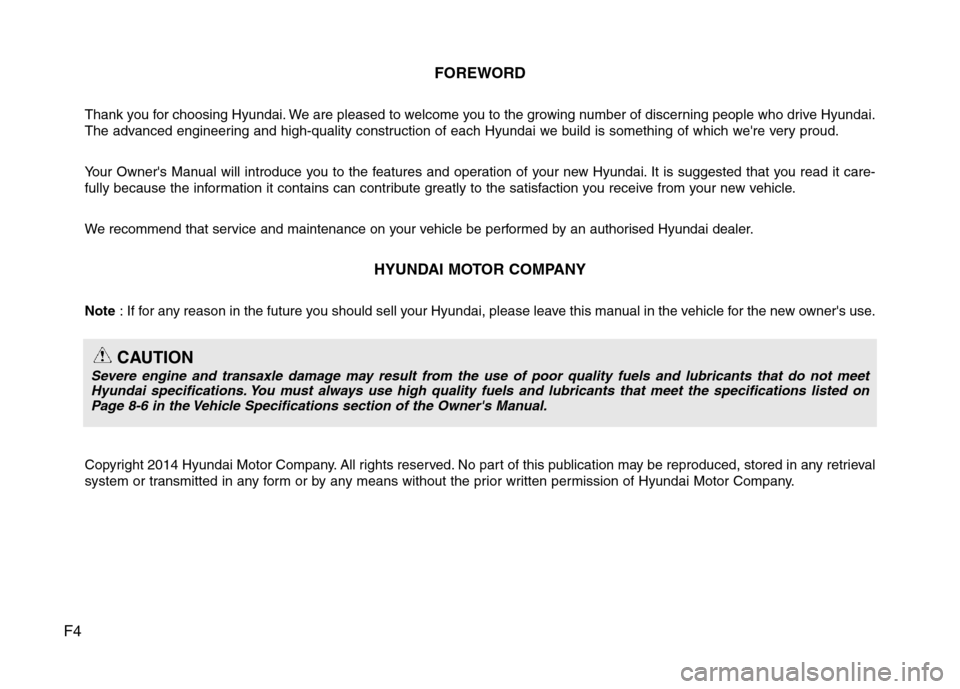
F4FOREWORD
Thank you for choosing Hyundai. We are pleased to welcome you to the growing number of discerning people who drive Hyundai.
The advanced engineering and high-quality construction of each Hyundai we build is something of which we're very proud.
Your Owner's Manual will introduce you to the features and operation of your new Hyundai. It is suggested that you read it care-
fully because the information it contains can contribute greatly to the satisfaction you receive from your new vehicle.
We recommend that service and maintenance on your vehicle be performed by an authorised Hyundai dealer.
HYUNDAI MOTOR COMPANY
Note: If for any reason in the future you should sell your Hyundai, please leave this manual in the vehicle for the new owner's use.
Copyright 2014 Hyundai Motor Company. All rights reserved. No part of this publication may be reproduced, stored in any retrieval
system or transmitted in any form or by any means without the prior written permission of Hyundai Motor Company.
CAUTION
Severe engine and transaxle damage may result from the use of poor quality fuels and lubricants that do not meet
Hyundai specifications. You must always use high quality fuels and lubricants that meet the specifications listed on
Page 8-6 in the Vehicle Specifications section of the Owner's Manual.
Page 7 of 498
F7
1
2
3
4
5
6
7
8
I
Introduction
Your vehicle at a glance
Safety features of your vehicle
Features of your vehicle
Driving your vehicle
What to do in an emergency
Maintenance
Specifications & Consumer information
Index
table of contents
Page 50 of 498
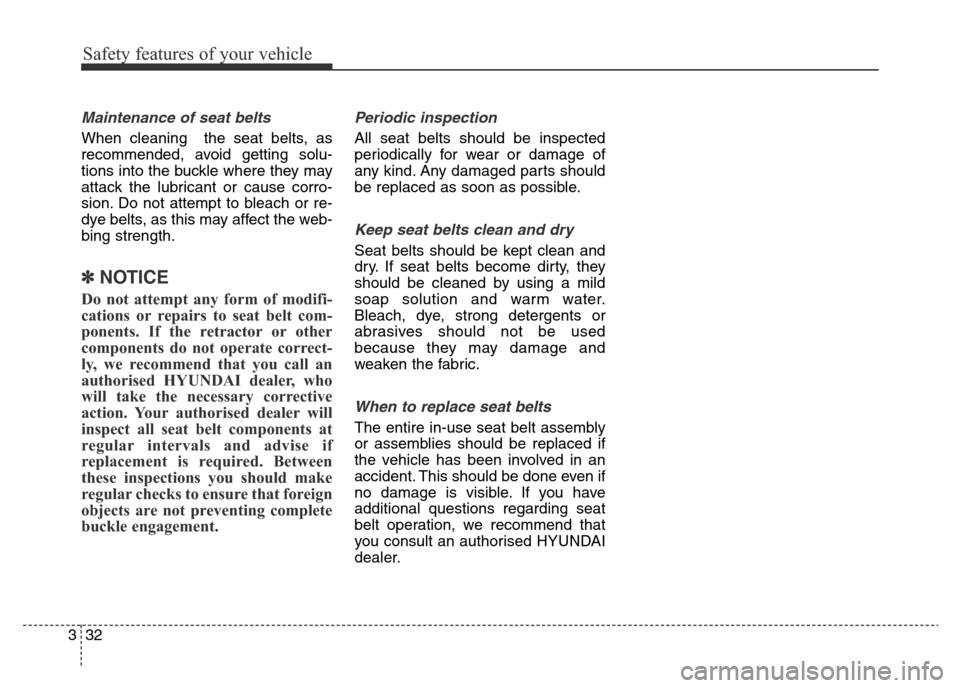
Safety features of your vehicle
32 3
Maintenance of seat belts
When cleaning the seat belts, as
recommended, avoid getting solu-
tions into the buckle where they may
attack the lubricant or cause corro-
sion. Do not attempt to bleach or re-
dye belts, as this may affect the web-
bing strength.
✽NOTICE
Do not attempt any form of modifi-
cations or repairs to seat belt com-
ponents. If the retractor or other
components do not operate correct-
ly, we recommend that you call an
authorised HYUNDAI dealer, who
will take the necessary corrective
action. Your authorised dealer will
inspect all seat belt components at
regular intervals and advise if
replacement is required. Between
these inspections you should make
regular checks to ensure that foreign
objects are not preventing complete
buckle engagement.
Periodic inspection
All seat belts should be inspected
periodically for wear or damage of
any kind. Any damaged parts should
be replaced as soon as possible.
Keep seat belts clean and dry
Seat belts should be kept clean and
dry. If seat belts become dirty, they
should be cleaned by using a mild
soap solution and warm water.
Bleach, dye, strong detergents or
abrasives should not be used
because they may damage and
weaken the fabric.
When to replace seat belts
The entire in-use seat belt assembly
or assemblies should be replaced if
the vehicle has been involved in an
accident. This should be done even if
no damage is visible. If you have
additional questions regarding seat
belt operation, we recommend that
you consult an authorised HYUNDAI
dealer.
Page 74 of 498
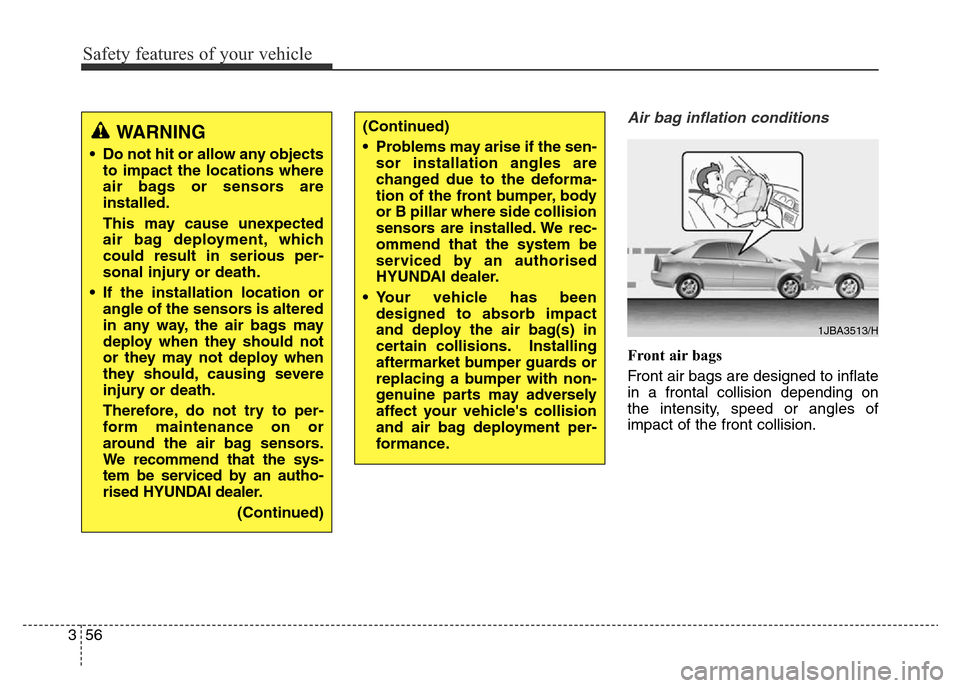
Safety features of your vehicle
56 3
Air bag inflation conditions
Front air bags
Front air bags are designed to inflate
in a frontal collision depending on
the intensity, speed or angles of
impact of the front collision.
WARNING
• Do not hit or allow any objects
to impact the locations where
air bags or sensors are
installed.
This may cause unexpected
air bag deployment, which
could result in serious per-
sonal injury or death.
• If the installation location or
angle of the sensors is altered
in any way, the air bags may
deploy when they should not
or they may not deploy when
they should, causing severe
injury or death.
Therefore, do not try to per-
form maintenance on or
around the air bag sensors.
We recommend that the sys-
tem be serviced by an autho-
rised HYUNDAI dealer.
(Continued)
(Continued)
• Problems may arise if the sen-
sor installation angles are
changed due to the deforma-
tion of the front bumper, body
or B pillar where side collision
sensors are installed. We rec-
ommend that the system be
serviced by an authorised
HYUNDAI dealer.
• Your vehicle has been
designed to absorb impact
and deploy the air bag(s) in
certain collisions. Installing
aftermarket bumper guards or
replacing a bumper with non-
genuine parts may adversely
affect your vehicle's collision
and air bag deployment per-
formance.
1JBA3513/H
Page 78 of 498
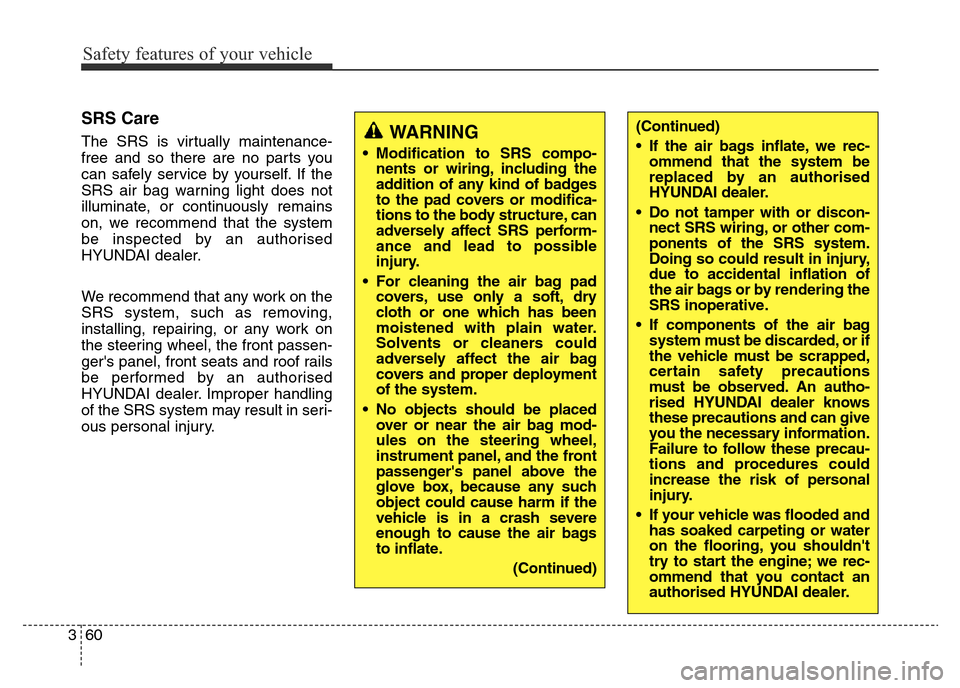
Safety features of your vehicle
60 3
SRS Care
The SRS is virtually maintenance-
free and so there are no parts you
can safely service by yourself. If the
SRS air bag warning light does not
illuminate, or continuously remains
on, we recommend that the system
be inspected by an authorised
HYUNDAI dealer.
We recommend that any work on the
SRS system, such as removing,
installing, repairing, or any work on
the steering wheel, the front passen-
ger's panel, front seats and roof rails
be performed by an authorised
HYUNDAI dealer. Improper handling
of the SRS system may result in seri-
ous personal injury.WARNING
• Modification to SRS compo-
nents or wiring, including the
addition of any kind of badges
to the pad covers or modifica-
tions to the body structure, can
adversely affect SRS perform-
ance and lead to possible
injury.
• For cleaning the air bag pad
covers, use only a soft, dry
cloth or one which has been
moistened with plain water.
Solvents or cleaners could
adversely affect the air bag
covers and proper deployment
of the system.
• No objects should be placed
over or near the air bag mod-
ules on the steering wheel,
instrument panel, and the front
passenger's panel above the
glove box, because any such
object could cause harm if the
vehicle is in a crash severe
enough to cause the air bags
to inflate.
(Continued)
(Continued)
• If the air bags inflate, we rec-
ommend that the system be
replaced by an authorised
HYUNDAI dealer.
• Do not tamper with or discon-
nect SRS wiring, or other com-
ponents of the SRS system.
Doing so could result in injury,
due to accidental inflation of
the air bags or by rendering the
SRS inoperative.
• If components of the air bag
system must be discarded, or if
the vehicle must be scrapped,
certain safety precautions
must be observed. An autho-
rised HYUNDAI dealer knows
these precautions and can give
you the necessary information.
Failure to follow these precau-
tions and procedures could
increase the risk of personal
injury.
• If your vehicle was flooded and
has soaked carpeting or water
on the flooring, you shouldn't
try to start the engine; we rec-
ommend that you contact an
authorised HYUNDAI dealer.
Page 130 of 498
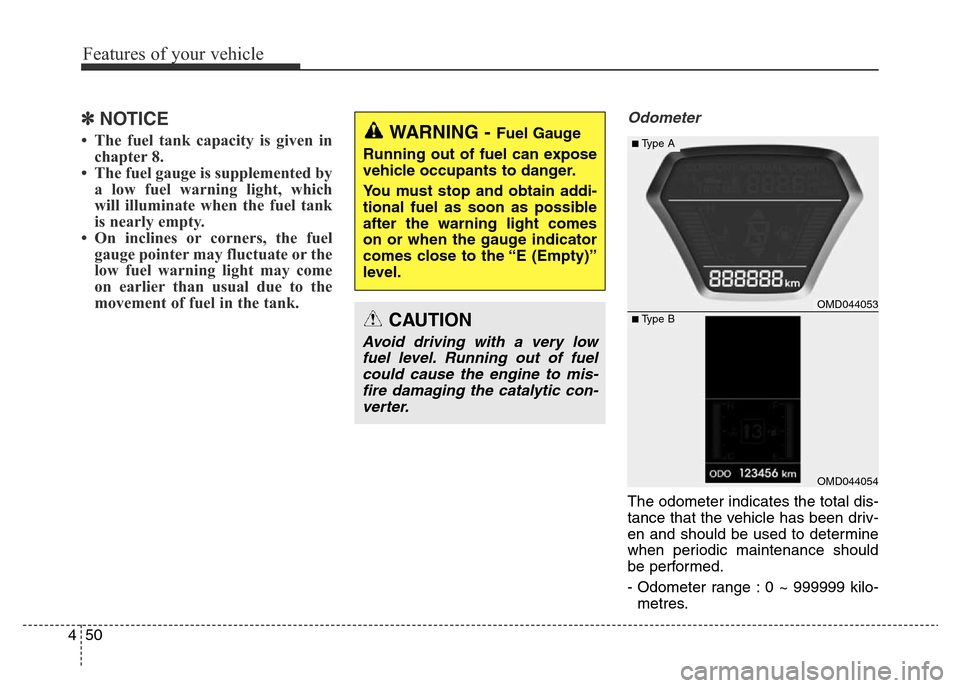
Features of your vehicle
50 4
✽NOTICE
• The fuel tank capacity is given in
chapter 8.
• The fuel gauge is supplemented by
a low fuel warning light, which
will illuminate when the fuel tank
is nearly empty.
• On inclines or corners, the fuel
gauge pointer may fluctuate or the
low fuel warning light may come
on earlier than usual due to the
movement of fuel in the tank.
Odometer
The odometer indicates the total dis-
tance that the vehicle has been driv-
en and should be used to determine
when periodic maintenance should
be performed.
- Odometer range : 0 ~ 999999 kilo-
metres.
WARNING - Fuel Gauge
Running out of fuel can expose
vehicle occupants to danger.
You must stop and obtain addi-
tional fuel as soon as possible
after the warning light comes
on or when the gauge indicator
comes close to the “E (Empty)”
level.
CAUTION
Avoid driving with a very low
fuel level. Running out of fuel
could cause the engine to mis-
fire damaging the catalytic con-
verter.
OMD044053
OMD044054
■Type A
■Type B
Page 139 of 498
459
Features of your vehicle
Shift Indicator (if equipped)
If this item is checked, the shift indi-
cator function will be activated.
Fuel ECO Auto Reset
• Auto Reset:
The average fuel economy will
reset automatically when refu-
elling.
• Manual Reset:
The average fuel economy will not
reset automatically whenever refu-
elling.
For more details, refer to “Trip
Computer” in this chapter.Steering position (if equipped)
If this item is checked, when starting
the engine, the alignement status of
the steering wheel is displayed.Service Interval (if equipped)
On this mode, you can activate the
service interval function by mileage
(km or mi.) and period (months).
✽NOTICE
If the service interval function is not
available in your vehicle, we recom-
mend that you consult an authorised
HYUNDAI dealer for maintenance
service information.
OMD044507L/OMD044508L